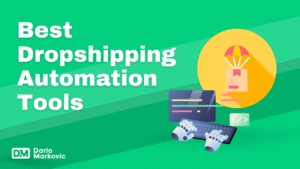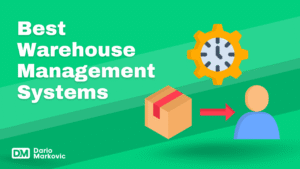Understanding the differences between dropshipping and ecommerce is crucial for navigating the world of online business in 2024. With the global ecommerce market projected to reach $6.3 trillion by 2024, there are huge opportunities for growth.
Dropshipping vs Ecommerce: Each model has its own advantages and disadvantages. Dropshipping allows retailers to sell products without holding inventory, while traditional ecommerce requires managing stock and fulfillment directly.
Key takeaway: Knowing the pros and cons of both dropshipping and ecommerce will help you make an informed decision for your online business this year.
Understanding Dropshipping
Dropshipping is a business model where retailers sell products without holding any inventory. Instead, they partner with suppliers who handle storage, shipping, and fulfillment directly to the customer.
This ecommerce model’s accessibility and low-risk nature make it an attractive option for first-time sellers aiming to dip their toes into online retail without significant upfront investment.
For a more detailed explanation of the dropshipping concept, you can refer to this comprehensive guide.
How Dropshipping Works
In dropshipping, you set up an online store and list products for sale. When a customer places an order:
- You forward the order details to your supplier.
- The supplier packages and ships the product directly to the customer.
- You earn a profit from the difference between your selling price and the supplier’s wholesale price.
To understand more about the mechanics of this business model, check out this in-depth article.
Pros of Dropshipping
Dropshipping offers several benefits that make it appealing, especially for new entrepreneurs:
- Low Startup Costs: No need to purchase inventory upfront, reducing initial financial risk.
- Flexibility in Product Offerings: Ability to offer a wide range of products without worrying about stock management.
- Low Financial Risk: Since you only purchase products after making a sale, there’s minimal risk of unsold inventory.
- Accessibility for First-Time Sellers: Simplified logistics make it easier for beginners to start an online business.
Cons of Dropshipping
While dropshipping has many advantages, there are also some challenges:
- Lower Profit Margins: Because you’re paying suppliers for fulfillment services, profit margins can be thinner compared to traditional ecommerce.
- Quality Control Issues: Limited control over product quality and shipping times can affect customer satisfaction.
- Highly Competitive Market: With many sellers offering similar products, standing out can be challenging.
For a better understanding of how dropshipping compares with other models like 3PL (Third Party Logistics), you can explore this detailed comparison.
Challenges with Dropshipping
Dropshipping comes with its unique set of challenges that can impact the overall success of your online business.
Lower Profit Margins
One of the primary challenges is lower profit margins compared to traditional ecommerce. Since you are purchasing products from third-party suppliers, they often come at higher prices, leaving less room for markup. This can make it difficult to compete on price, especially in a saturated market.
Product Quality and Shipping Times
Another significant issue is the limited control over product quality and shipping times. Because you rely on suppliers to fulfill orders, any delays or quality issues directly affect your customer satisfaction. Negative reviews and returns can pile up quickly if the products don’t meet customer expectations or arrive late.
Competitive Market Landscape
The dropshipping model’s low barrier to entry creates a highly competitive market landscape. With many sellers offering similar products, standing out becomes challenging. Effective marketing strategies and exceptional customer service are crucial but don’t always guarantee success in such a crowded space.
Navigating these challenges requires strategic planning and careful selection of reliable suppliers to ensure that your dropshipping business remains viable and competitive.
Understanding Ecommerce
Definition of Ecommerce
Ecommerce, short for electronic commerce, refers to the buying and selling of goods or services using the internet. It includes various business models, from large retailers like Amazon to small specialized online stores.
With ecommerce, businesses can reach customers worldwide by using digital platforms to promote and sell products directly.
Inventory Management and Fulfillment Processes
One important aspect of ecommerce is inventory management. This involves keeping track of how much stock you have, managing your storage needs, and making sure products are replenished on time. By effectively managing your inventory, you can avoid running out of stock or having too much inventory, both of which can hurt your sales and profits.
In ecommerce, fulfillment processes refer to the tasks involved in preparing and delivering orders. This includes picking items from the warehouse, packing them securely, and shipping them to customers. Retailers have the option to handle these tasks themselves or hire third-party logistics providers (3PLs) to do it for them.
While outsourcing can save time and reduce labor costs, it’s important to carefully choose reliable partners for this.
Moreover, as highlighted in recent global ecommerce trends, there are significant opportunities for freight forwarders in cross-border ecommerce fulfillment. This aspect of fulfillment is becoming increasingly important as businesses look to expand their reach into international markets.
Market Size and Potential Growth in 2024
The global ecommerce market is expected to reach an impressive $6.3 trillion by the end of 2024. This growth is driven by more people getting access to the internet, increased smartphone usage, and a growing preference for online shopping among consumers.
For businesses entering the ecommerce industry, there are significant opportunities for expansion and generating revenue.
Pros and Cons of Ecommerce Model
Here are some advantages and disadvantages of the ecommerce model:
Pros:
- Higher profit margins: With direct control over sourcing and pricing strategies, profit margins can often exceed 40%.
- Enhanced control over branding: Custom packaging and quality checks allow businesses to create a unique brand experience.
- Scalability: It becomes easier to expand product lines and grow the business due to direct oversight of operations.
Cons:
- Higher initial investment: Costs associated with inventory purchase, warehousing, and logistics management can be significant.
- Labor-intensive fulfillment processes: Handling order fulfillment can be demanding unless outsourced.
- Inventory risks: Outdated stock or shifts in market trends can lead to unsold inventory.
The decision between dropshipping and ecommerce depends on several factors such as budget constraints, desired control level over products, target market characteristics, and the retailer’s ability to effectively manage logistics.
Comparing Dropshipping and Ecommerce Models: Which One is Right for You?
Key Differences in Operational Approaches
When you compare dropshipping and ecommerce models, the operational differences stand out clearly:
Dropshipping:
- Inventory Management: No need to purchase or manage inventory.
- Fulfillment: Suppliers handle storage, shipping, and fulfillment.
- Startup Costs: Lower initial investment due to no inventory purchases.
Ecommerce:
- Inventory Management: Requires purchasing and managing stock.
- Fulfillment: Retailers handle or outsource warehousing and shipping.
- Startup Costs: Higher initial investment for inventory and logistics.
Profitability Comparison
- Dropshipping: Typically lower profit margins as suppliers charge higher prices for products.
- Ecommerce: Higher profit margins due to direct control over sourcing and pricing strategies.
Control Over Quality
- Dropshipping: Limited control over product quality and shipping times, impacting customer satisfaction.
- Ecommerce: Greater control over product quality, branding, and customer experience through custom packaging and quality checks.
Scalability Potential
- Dropshipping: Flexible product offerings without stock management burdens; ideal for testing new markets.
- Ecommerce: Better scalability potential for building a brand and expanding product lines effectively.
Factors to Consider When Choosing Between Dropshipping and Ecommerce
Several factors can guide your decision:
Budget Constraints
- Dropshipping suits those with limited budgets due to lower startup costs.
- Ecommerce requires a higher initial investment but offers greater profitability in the long run.
Desired Control Level
- Dropshipping involves less control over product quality and fulfillment processes.
- Ecommerce allows for extensive control over every aspect of the business, from sourcing to customer service.
Recommendations
New Sellers: Dropshipping can be an accessible entry point into online retailing with minimal risk.
Established Brands: Traditional ecommerce provides better opportunities for brand building, customer loyalty, and higher profit margins.
Market Trends in 2024: The Future of Online Business Models
The global ecommerce market is set for remarkable growth, with projections indicating it will reach a staggering $6.3 trillion by 2024. This expansion reflects an increasing consumer preference for online shopping and the continuous evolution of technology facilitating smoother transactions.
Key Trends Shaping the Future
Here are some key trends that are expected to shape the future of online business models:
- Ecommerce Growth: With advancements in digital payment systems, enhanced logistics, and personalized shopping experiences, ecommerce is positioned to dominate.
- Dropshipping Expansion: The dropshipping sector is also on the rise, expecting to grow to approximately $243.42 billion by 2026, driven by low entry barriers and flexible business opportunities.
These trends highlight the significant potential for both models as viable pathways for entering and thriving in the online retail space.
Dario`s Summary
Choosing between dropshipping and ecommerce depends on understanding their key differences and how they fit with your business goals.
Dropshipping Highlights
- Low Financial Risk: Minimal upfront investment as inventory purchase isn’t required.
- Flexibility: Wide range of products without the burden of stock management.
- Accessibility: Ideal for first-time sellers due to lower stakes involved.
Dropshipping Drawbacks
- Profit Margins: Typically lower due to higher supplier costs.
- Control Issues: Limited influence over product quality and shipping times.
- Competitive Landscape: Saturated market with many sellers offering similar items.
Ecommerce Highlights
- Profit Margins: Potentially higher, thanks to direct control over sourcing and pricing.
- Branding Control: Enhanced customer experience through custom packaging and quality checks.
- Scalability: Greater potential for expanding product lines and building a brand.
Ecommerce Drawbacks
- Initial Investment: Higher costs for inventory, warehousing, and logistics.
- Labor Intensive: Order fulfillment can be time-consuming unless outsourced.
- Inventory Risks: Challenges with outdated stock or shifts in market trends.
Choosing the Right Model
Consider factors like budget constraints, desired level of control, market characteristics, and logistical capabilities. New entrepreneurs might lean towards dropshipping for its low entry barriers, while established brands may prefer ecommerce for greater control and profit potential.
Frequently Asked Questions about Dropshipping vs Ecommerce
What are the advantages of dropshipping?
The advantages of dropshipping include low startup costs, flexibility in product offerings, low financial risk due to no inventory purchases, and accessibility for first-time sellers.
Retailers can offer a wide range of products without managing stock.
What challenges do dropshippers face?
Dropshippers face challenges such as limited control over product quality, lower profit margins compared to traditional ecommerce models, issues with shipping times affecting customer satisfaction, and operating in a highly competitive market landscape.
How does ecommerce differ from dropshipping?
Ecommerce involves direct control over inventory management and fulfillment processes. It typically requires higher initial investments for inventory and logistics but allows for greater profit margins and control over branding and customer experience.
What factors should I consider when choosing between dropshipping and ecommerce?
When choosing between dropshipping and ecommerce, consider factors such as your budget constraints, desired level of control over product quality, scalability potential, and whether you are a new seller or an established brand looking to expand.
What are the market trends for online business models in 2024?
Market trends indicate significant growth in the global ecommerce market, projected to reach $6.3 trillion by 2024. Understanding these trends can help you make informed decisions about which business model to pursue.



